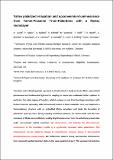Valley polarized relaxation and upconversion luminescence from Tamm-plasmon trion-polaritons with a MoSe2 monolayer
Abstract
Transition metal dichalcogenides represent an ideal testbed to study excitonic effects, spin-related phenomena and fundamental light-matter coupling in nanoscopic condensed matter systems. In particular, the valley degree of freedom, which is unique to such direct band gap monolayers with broken inversion symmetry, adds fundamental interest in these materials. Here, we implement a Tamm-plasmon structure with an embedded MoSe2 monolayer and study the formation of polaritonic quasi-particles. Strong coupling conditions between the Tamm-mode and the trion resonance of MoSe2 are established, yielding bright luminescence from the polaritonic ground state under non-resonant optical excitation. We demonstrate, that tailoring the electrodynamic environment of the monolayer results in a significantly increased valley polarization. This enhancement can be related to change in recombination dynamics shown in time-resolved photoluminescence measurements. We furthermore observe strong upconversion luminescence from resonantly excited polariton states in the lower polariton branch. This upconverted polariton luminescence is shown to preserve the valley polarization of the trion–polariton, which paves the way towards combining spin-valley physics and exciton scattering experiments.
Citation
Lundt , N , Nagler , P , Nalitov , A , Klembt , S , Wurdack , M , Stoll , S , Harder , T H , Betzold , S , Baumann , V , Kavokin , A V , Schüller , C , Korn , T , Höfling , S & Schneider , C 2017 , ' Valley polarized relaxation and upconversion luminescence from Tamm-plasmon trion-polaritons with a MoSe 2 monolayer ' , 2D Materials , vol. 4 , no. 2 , 025096 . https://doi.org/10.1088/2053-1583/aa6ef2
Publication
2D Materials
Status
Peer reviewed
ISSN
2053-1583Type
Journal article
Description
This work has been supported by the State of Bavaria and the ERC (unlimit-2D) as well as the DFG via grants GRK 1570, KO3612/1-1 and SFB 689.Collections
Items in the St Andrews Research Repository are protected by copyright, with all rights reserved, unless otherwise indicated.

